- Home
- Collections
- HOLLYWOOD G
- Various
- Napier - New Zealand's Switched-On City
Napier – New Zealand’s Switched-On City
NAPIER – NEW ZEALAND’S SWITCHED-ON CITY.
Where in the world would you find a place where there’s more to see and do than in Napier City.
It was an Australian journalist who called Napier – ‘New Zealand’s Switched on City’. He dropped in for a couple of days to see if there was a story in the place and found there was so much to see and do; so much to write and rave about . . . he stayed not two days but 10! So when visitors go to Napier – and the people there just love to have visitors with them – they find there’s so many ways to relax, have fun in the sun, swim, fish laugh and live, that they wonder where to start and how they are going to take it all in during their Napier vacation. Any day is a holiday in Napier – and every eve is Christmas Eve when the golden mile of the Marine Parade becons [beckons] the visitor to “come on in and have fun” among the myriad fairy lights in a scintilating [scintillating] setting of sparkling Christmas Trees.
There’s never a dull moment in Napier City – they don’t know the meaning of the words. They don’t appear in the Napier dictionary.
There are folk there – 41,00 [41,000] of them who want to meet visitors and make them welcome. They want their guests to enjoy for a while what they enjoy every day of the year.
And there are some other “folk” who want to say “Hello” to the visitor to Napier –
The dolphins, sea lions, sea leopards and other animals and sea birds at Marineland of New Zealand.
The kiwis, who are prepared to wake up in the middle of THEIR night to let the visitors have a look at that comical wingless bird which New Zealand has as its emblem.
The gannets on their precipitous tip of Cape Kidnappers waiting for the visitors to arrive by safari wagon overland or by horseback around the beach to see them.
The free-flying budgies, peacocks, doves and native birds in the Botanic gardens.
And the fish in the sea, lakes and rivers waiting for the visitor to catch them – if he can.
But that’s up to the visitor.

2/
Napier certainly offers all that good in New Zealand . . . in a “packaged deal “.
Visitors can swim in the sea, go surfing or skin diving, go hunting, shooting, climb a mountain if they like.
Go sailing, play bowls, croquet, tennis, squash, badminton or billiards.
Eat, drink, ride a horse, sample wines where they’re made, pick a ripe juicy apple, pear peach or plum, go out on a farm or visit a factory.
Sit in the sun – or the shade – picnic by a river or on a sandy beach, be entertained, go for walks or just sit around and relax. You name it Napier has it. !
Water sports and recreation are a very familiar pass time in Napier.
With its surfing, swimming or fishing beaches – sand or shingle you take your pick – salt water and fresh water swimming pools for adults and children, boat and yachting harbour, stretches of rocky coastline and tranquil riverside picnic spots, you can enjoy yourself over, under or near the water in Napier.
Napier City’s Marine Parade is as famous as it is fascinating. This Golden Mile, of the Pacific Coast packages such a line-up of beauty and entertainment that it becomes a real holiday adventureland with something to entertain and amuse the visitor in each of its 1760 yards.
Napier City has the distinction of being the first sizeable place in the world that the sun shines on every day. Maybe that’s why the sun seems to have a “thing” about Napier . . . it’s always reluctant to leave the place. It stays with it most of the time.
It warms the beaches, the water in the swimming pools . . . and the people’s welcome to the visitor.
They have a saying in Napier: “If the sun’s not shining. . . its because they need the rain.”
“GOLDEN MILE” OF THE MARINE PARADE.
It is unlikely that anywhere you’ll come across anything that quite matches Napier’s Marine Parade. The mile long beach front offers a unique concentration of pleasure and entertainment. The features cater for all ages and is undoubtedly New Zealand’s finest beach front development.
At the northern (Hill) end of the Parade a shady picnic area has been developed where the visitor can park his car and have a picnic at the tables and chairs provided.
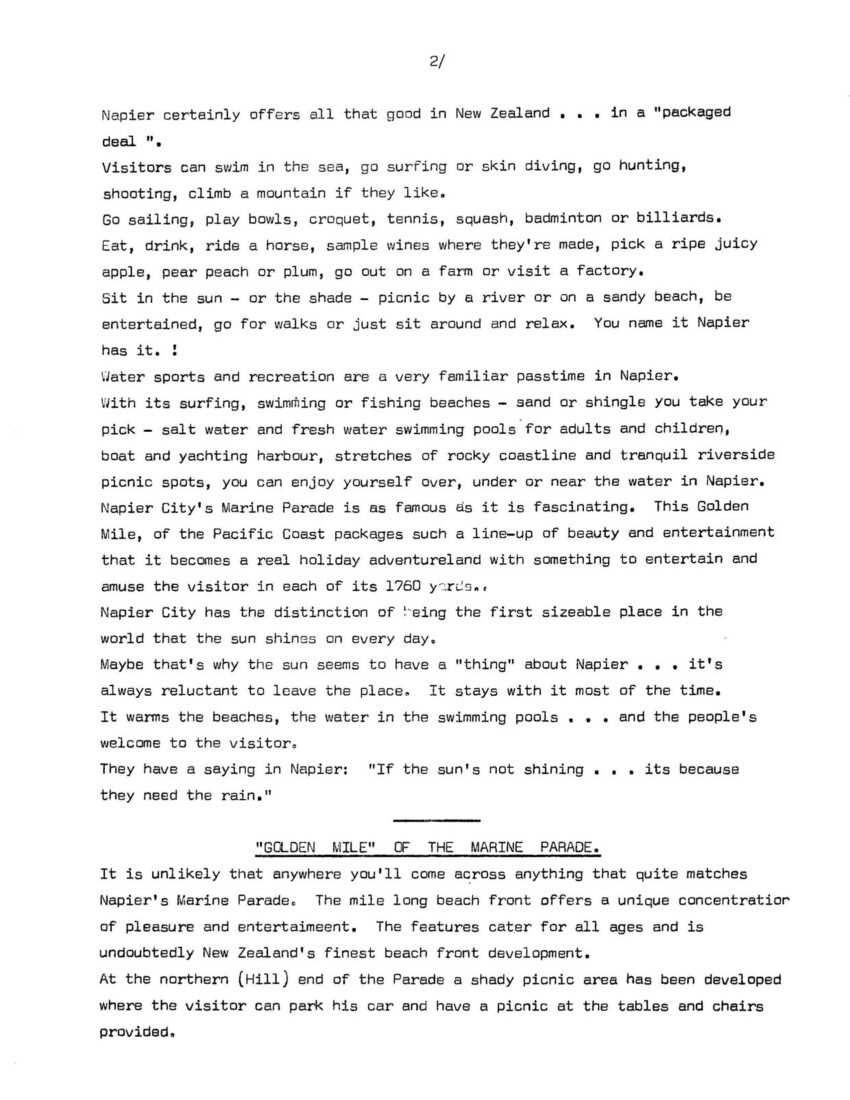
3/
That is the start of the famous “Golden Mile” . . .
Travelling south along the parade from the picnic area the next feature is the novel octagonal Kiwi Display House surrounded by Native Trees and shrubs and in the forecourt an attractive headquarters building for the surf life-saving club [that] stands alongside.
Then there is the Children’s playground with all imaginable play devices for children including a shallow paddling pool for the toddlers.
Then comes the Lido salt water swimming pool with its glass surround of windbreaks and complete with its dairy/milk bar for refreshments and alongside is Napier’s War Memorial Building fronted by a licensed restaurant and containing a conference and dance hall. This novel circular building is a feature of the northern end of the Marine Parade. In the basement is the wonderful world of the Hawke’s Bay Aquarium.
A living floral clock fronting the building on the Parade sets the main for the entrance to the Marine Parade gardens; immaculately kept lawns, shrubs and trees dotted with features such as the electric coloured fountain and Pania of the Reef statue for which Napier has become particularly well known.
Paths on either side of the gardens provide walkways for the visitor and allow him to examine at close quarters all the many features he will encounter on a stroll along the parade.
Next major feature is the colonade [colonnade], auditorium and sound shell complex which was the first major feature built in the Marine Parade development. Here the visitor will find an attractive sun dial, gazing bowl, sun bay, and the Veronica’s Bell, which rings the old year out and the New Year in for Napier City. The bell was a gift to the city from the naval sloop Veronica which gave Napier great assistance at the time of the 1931 earthquake.
From the Sound Shell entertainment programmes are presented during the main holiday season.
Just South of the Sound Shell is the putting green and information centre. The putting green provides a relaxing attraction and also provides facilities for skittles and lawn bowls.
Next comes the city’s latest garden attraction – the sunken garden. This replaced redundant tennis courts and is unique in New Zealand. Little waterways, a reconstructed water wheel and a delightful floating piece of sculpture all add to the delight of the sunken garden.
The top roller skating facilities of the Napier Skating Club’s rink follow the sunken garden. Here visitors can hire skates and become participants on the rink or be content to watch the colourful and exciting scene.

4/
Between the Skating Rink & Marineland of N.Z. is sited a large public car park and then comes Napier’s top parade feature – Marineland of New Zealand with its performing dolphins, sea lions, sea leopards and other marine animals.
Adjoining Marineland is the boating lake where children and adults can enjoy themselves in boats which cannot be capsised [capsized]. And around the perimeter of the lake a colourful minature [miniature] train takes children for rides. Just south of the boating lake is another children’s playground with modern and attractive equipment.
And that completes just 1760 yards – one mile – of attractions which are absorbing and interesting to the visitor.
But another half-mile further south is under development. And with the fertile ideas of the people of Napier which have already created the “Golden Mile” visitors can be assured that each year there is something new and something novel to interest, amuse and entertain them on Napier’s Marine Parade.
LILLIPUT VILLAGE AND RAILWAY.
“The most fascinating thing I’ve ever seen seen . . .”
This is the comment of most visitors when they see Napier’s Lilliput Animated Village and Railway housed in a new building on the Marine Parade.
The animated village and railway took Mr W. Knapp of Nelson 25 years to build, and the complex was aquired [acquired] by Napier as a visitor attraction in 1970. It was first housed in the former Council Chamber but it proved such a popular feature that a new building was erected to house it.
The building is an extension of the Planetarium building which is being developed into a bold concept of minatures [miniatures] and models, scientific and other interesting displays.
The Lilliput Village and Railway is an absorbing and fascinating display which demands the attention of visitors to Napier. The animated village contains the most perfect minature animation one could imagine. Tiny figures less than half-an-inch high go about their work in the village, cars travel the streets, men build and paint houses, a saw mill turns out timber, a drive-in theatre shows a colour film of Napier’s Marineland, in an autocourt attendants repair punctures, fill petrol tanks, oil and grease cars on a hoist and so on and so on in what seems to be a never-ending array of the most intricate minature animation imaginable.

5/
And through it all runs the railway with exact model replicas of all New Zealand’s railway locomotives and carriages all hand made and correct to the finest detail. The gaily-coloured reliefed landscape and tiny buildings all contribute to the bird’s eye view of a bustling little community going about the business of living.
A seperate [separate] section of animated nursery rhymes is of particular interest to the tiny tots.
The Lilliput Village and Railway is another of Napier’s great line-up of entertaining attractions.
MARINELAND OF NEW ZEALAND.
Almost a quarter of a million people a year acclaim Marineland of New Zealand in Napier the country’s top entertainment attraction.
The all-star show of performing dolphins, sea lions, sea leopards, penguins, seals and other ocean creatures is recognised throughout the world for a number of “firsts” in this type of show.
Marineland of N.Z. in Napier has the distinction of training and performing the first ever Sea Leopard – the most ferocious of all the sea animals; it was the first Marineland in the world to successfully tame and train the Common Dolphin and it is the home of the now famous “Flash” the sealion.
Sited strategically on Napier’s Marine Parade, Marineland of New Zealand provides visitors with exciting entertainment by the clowns and acrobats of the ocean together with an educational experience which is unique in the country.
In the six years that it has been operating, Marineland has grown from a single pool and one dolphin to a major complex of a dozen pools and teams of performing dolphins including four different species, sea lions and sea leopards, penguins, gannets and other sea birds.
Performances by the animals are well conceived and well rehearsed to present a smooth-flowing show with dolphins leaping 20 feet into the air to bounce rubber balls, leaping through hoops of fire, swimming backstroke, playing water polo (and shooting goals with unerring accuracy), coming right out of the water on a concrete slab to say Hello to the folks, tail-walking the length of the arena, executing back flips and doing other acts which leave the audience breathless.
The savage Sea Leopards dress up for the occasion in top hat, white tie and tails, play cricket with the trainer, applaud the audience with their flippers, provide the motor power for a hair-raising boat ride by the trainer, retrieve articles from the surface and the bottom of the pool and generally clown their way through an astounding section of the programme.
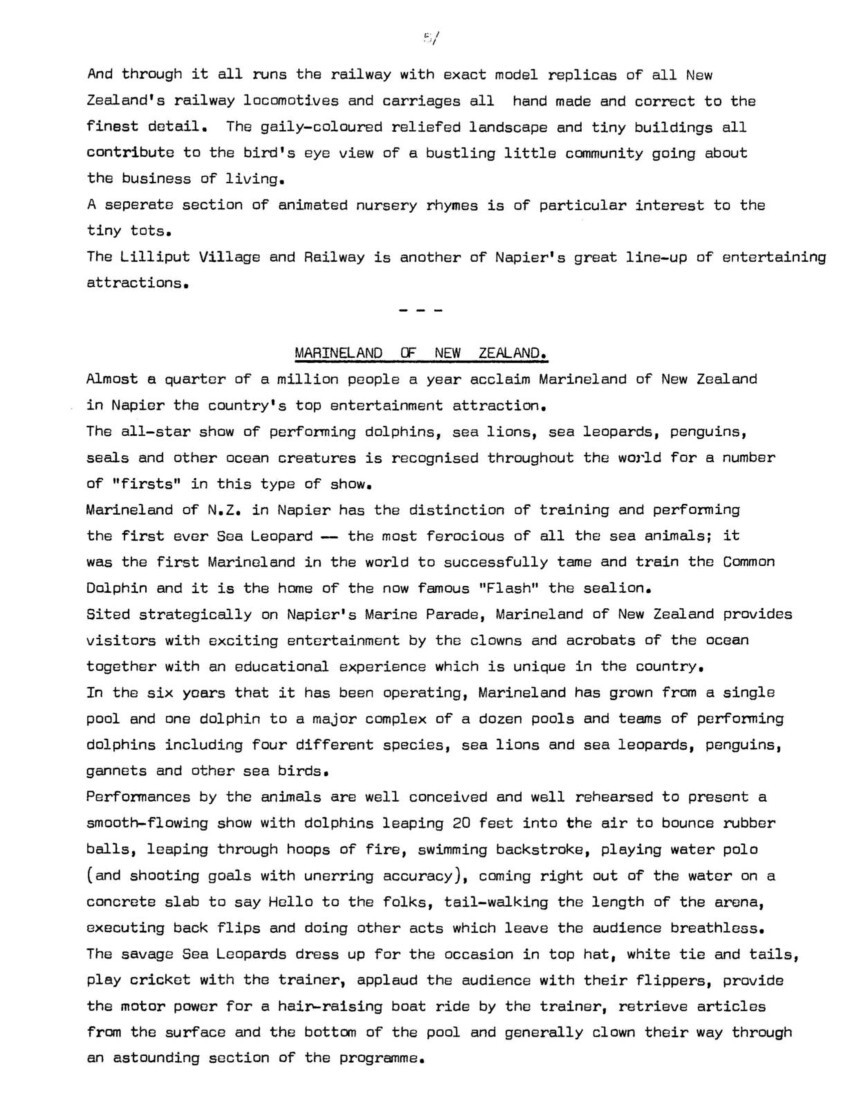
6/
But the real clowns of the Marineland show are the Sea Lions. Star performer “Flash” is renowned in New Zealand and widely recognised throughout the world for his inimitable personality on stage or in the water.
“Flash’s” routine is so full of surprises and laughs that he is the favourite of everyone. He is a highly intelligent animal and his trainers will tell you that some of his acts are his own idea. His astounding feats of balancing balls on the end of sticks, barbells, balancing on one flipper with a ball on his nose, trundling around the stage on front flippers only with face and hands, posing for the photographers, waving to the people, robbing the bank, going to gaol, taking a shower . . . these are only some of the highly entertaining things that this animal has in his repertoire. There just seems nothing that “Flash” can’t do.
Through underwater windows, the visitors to Marineland can view the animals in their natural element. And they are experts at giving the “close-up” when they swim slowly past or even up to the windows to make it a two-way affair.
Comical little Blue Penguins share their enclosure with a group of Gannets and other sea birds. The little penguins are, of course, popular with the people. When they venture into one of the main arenas to compete with the dolphins for food they show their terrific speed in the water to the delight of everyone. And when they play on their water slide, climbing to the top and then sliding down into the pool there’s a laugh a second at Marineland.
Marineland of New Zealand in Napier is the place where everybody wants to go . . . and nobody wants to go away from. There is never a dull moment . . . the animals see to that.
KIWIS ON DISPLAY.
Napier is the one place in New Zealand where the visitor can meet and photograph New Zealand’s famous bird – the Kiwi.
Of course there are other places in New Zealand where kiwis are kept in captivity but the establishment of a new Kiwi House on Napier’s Marine Parade enables the visitor to see the kiwis under all weather conditions and to great advantage.
The kiwis are housed permanently in the city’s botanic gardens where they live in their burrows by day and roam their grassed enclosures by night. Being a nocturnal bird, the kiwi is seldom seen and it would be reasonable to suggest that more than 90 per cent of New Zealanders have never seen the strange bird which is the emblem of their country.

7/
In Napier the kiwi is displayed in the new Kiwi House in a manner which allows the visitor to view the bird at the closest possible quarters. If kiwis shook hands, then you could shake hands with it.
The kiwi house has been built with a clear section of roof which allows maximum light and photographs can be taken of the bird on display without the use of flashlights. The birds are displayed on a raised dias [dais] fringed by growing ferns and portions of the building interior have been lined with tree fern trunks to give the interior the real bush atmosphere.
The curator of the Hawke’s Bay Wildlife Trust – which has the Government Authority to keep the birds in captivity and display them in the public interest – is a world authority on kiwis and is a versatile and accomplished commentator when displaying the kiwis to visitors.
GANNET SAFARI.
N.Z.’s Most Exciting Overland Ride.
Out on the tip of Cape Kidnappers at the southern end of Hawke Bay is the only Gannet colony on the mainland in the world. Thousands of these great sea birds make this their home over the breeding season from September to April and a visit to the colony is a rich and rewarding experience.
Up until 1968 the only way to get to the colony was by walking on the beach around the base of the towering cape cliffs – a return distance of about 12 miles.
And this had to be accomplished over the period of low tide … a strenuous and often hazardous operation.
The development of an overland track in 1968 saw the birth of “Gannet Safari” which is billed as “New Zealand’s most exciting overland ride”. And surely it must be just that!
Gannet Safari is a 50 miles return journey from the base in Napier City in Safari “wagons” specially built for the task.
Each of the massive four-wheeled drive vehicles carries 25 passengers on the coastal drive to the base of the cape at Clifton. But then the wagons leave the road and turn inland to grind their way up stream beds through bush-lined valleys until they finally emerge on the cape highlands to give a breath-taking panoramic view of the plains, the mountains and the blue Pacific ocean.
Sheep, cattle and horses graze the highlands paddocks and seem to nod aquaintance [acquaintance] to the safari wagons as they pass. The track winds into gorges and out again. The wagons rumble up grades of one in three and pass along the clifftops and stop here and there to let the passengers photograph or view the unique scenery.
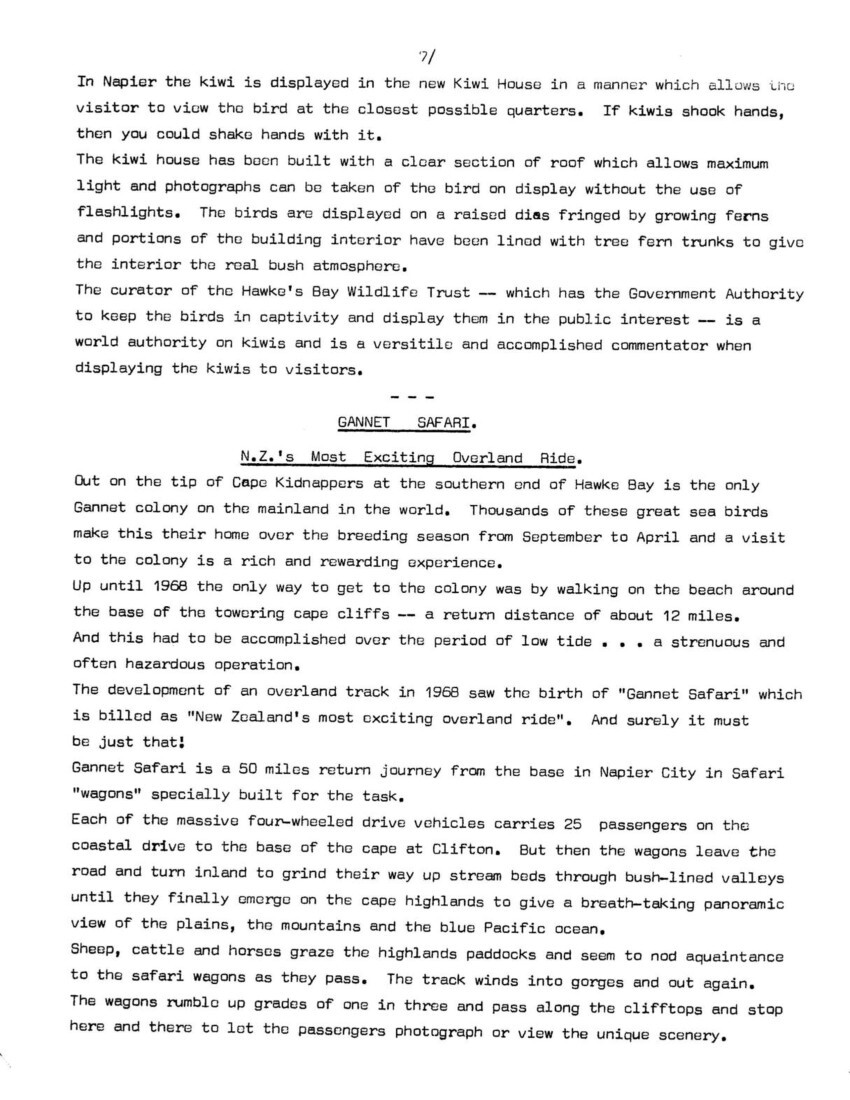
8/
Gannet Safari is an open-air affair. The wagons are sturdy open-sided vehicles allowing an unrestricted view of the entire trip. But there are side curtains which can be lowered and a running commentary is given by the driver who explains through a speaker system the great many points of interest on the trip.
Finally the safari wagons roll out on to a small plateau almost at the tip of the cape. As the passengers disembark they see the gannets wheeling in the air above them and swooping in to land on the high plateau of the cape a few hundred yards above the wagons.
A short uphill walk with rest seats on the way and the safari passengers are at the gannet colony.
And what a breath-taking view awaits them. To the north is the wide sweep of Hawke Bay with Napier City in the hazy distance. To the south the East Coast sweeps away towards Castlepoint the foreground and Bare Island breaking the seascape. But there is more to look at right at hand. Thousands of gannets on their nests, eggs, chicks in various stages of development and adult birds making their spine-chilling dives into schools of fish below.
Camera shutters click as the photographers have a real day out among the birds. And you can approach to within about six feet of them and get a real “head and shoulders”.
An hour at the colony with the driver/guide/ranger telling you the whole story and its back down the track to the safari wagons and the thrilling ride back to Napier. But there’s a stop on the way for refreshments. At about the time when everybody’s feeling just like a cup of coffee or tea the wagons suddenly wheel off the track to the shade of some bush trees and there the tables are set for coffee/tea and biscuits and a general comfort stop.
Gannet Safari is a four-hour journey – but every minute of it has its thrills and excitement. Even in its short four seasons it has become world famous to the degree that each year parties of Americans are visiting New Zealand for the sole purpose of taking Napier’s Gannet Safari . . . the country’s most exciting and thrilling overland ride.
HAWKE’S BAY AQUARIUM.
In the basement of the circular War Memorial building towards the northern (Hill) end of the Marine Parade is sited the Hawke’s Bay Aquarium.
Both freshwater and sea water tanks contain the most comprehensive collection of fish imaginable including many of the colourful inhabitants of the coral reefs of the Pacific.
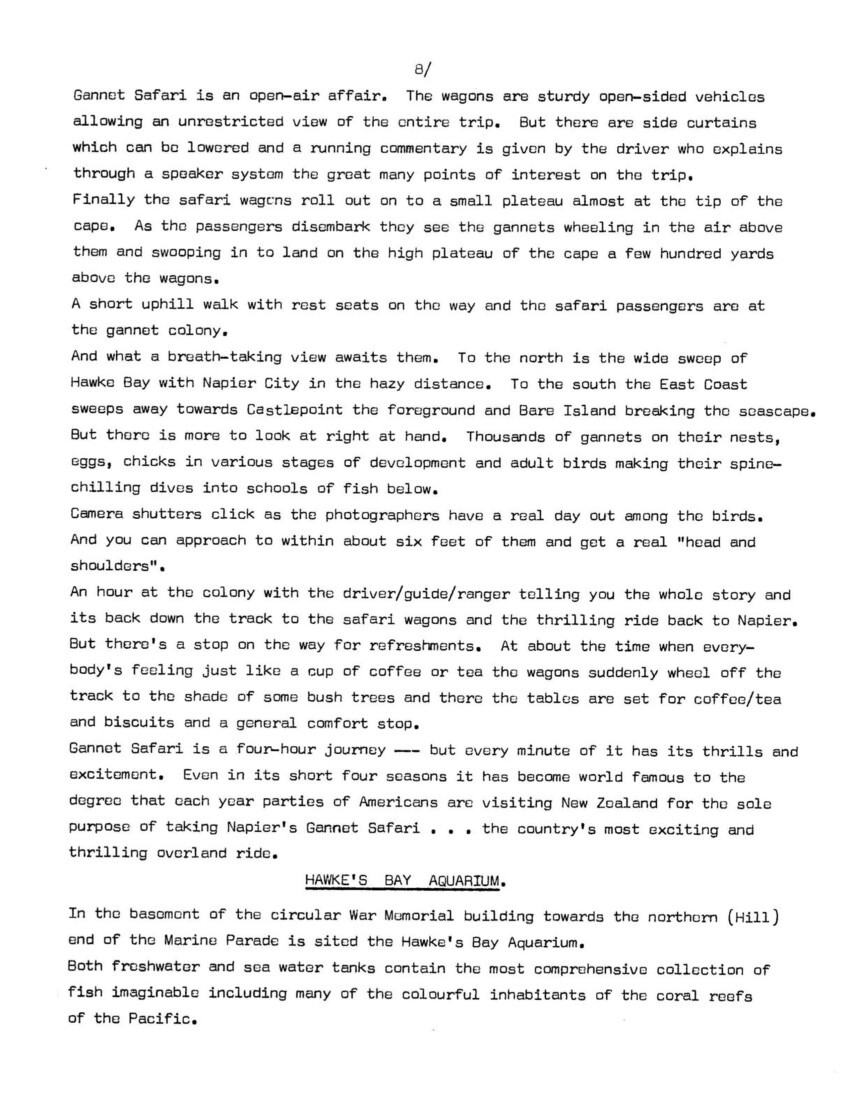
9/
In addition to these is a representative display of the fish to be found in New Zealand waters and a number of reptiles from New Zealand and overseas countries.
All the fish and reptiles in the aquarium are particularly well displayed in tanks and enclosures brilliantly lit by overseas illumination methods and some which have been specially devised by the aquarium staff.
The aquarium is specially known for its display of sea horses and is the envy of many overseas aquariums for this particular feature.
PARKS AND PLAYGROUNDS.
Napier City is blessed with more parks and open playgrounds than probably any other city in New Zealand.
The history of the City Parks is closely associated with the development of Napier from 1855 to the present day. It is a sobering thought that hardly more than 60 years ago, apart from the Botanic Gardens and Clive Square, nearly all the present day parks were then either swamps, lagoons or under sea water.
In the following information on the City Parks and reserves is given the date when it was developed or set aside and size.
Botanic Gardens: 1885, 12 acres. (Chaucer Road. Down Emerson Street, past Clive Square; second turning on right.)
The first trees planted in the gardens arrived by sailing ship. The gardens are noted for their mature trees, lovely sloping lawns, free – flying budgerigas [budgerigars] in the trees, peacocks, doves and aviary birds. Christmas night special feature “Carols By Candlelight”.
Clive & Memorial Squares: 1860, 3 acres. (Down town Centre) Lower Emerson Street. Memorial Square, nearest the hill, is the site of the Cenotaph and the women’s rest. Clive Square on the opposite side of Emerson Street provides a central city rest area with well-kept gardens, fish pond and decorative trees. This square was covered with temporary shops after the 1931 earthquake. The twin squares remain today a green and restful oasis for shoppers and city workers to rest awhile.
Marine Parade: 1888, 25 acres.
New Zealand’s most popular playground/garden. So far only 13 acres have been developed. The latest attraction is the Sunken Garden built at a cost of $43,000.
Nelson Park: 1909, 20 acres. (Entrances off Kennedy Road and Latham Street.)
An oval sports park with roadway around circumference and substantial planted area. Used for Soccer in Winter and Cricket in Summer. Tennis courts adjacent.
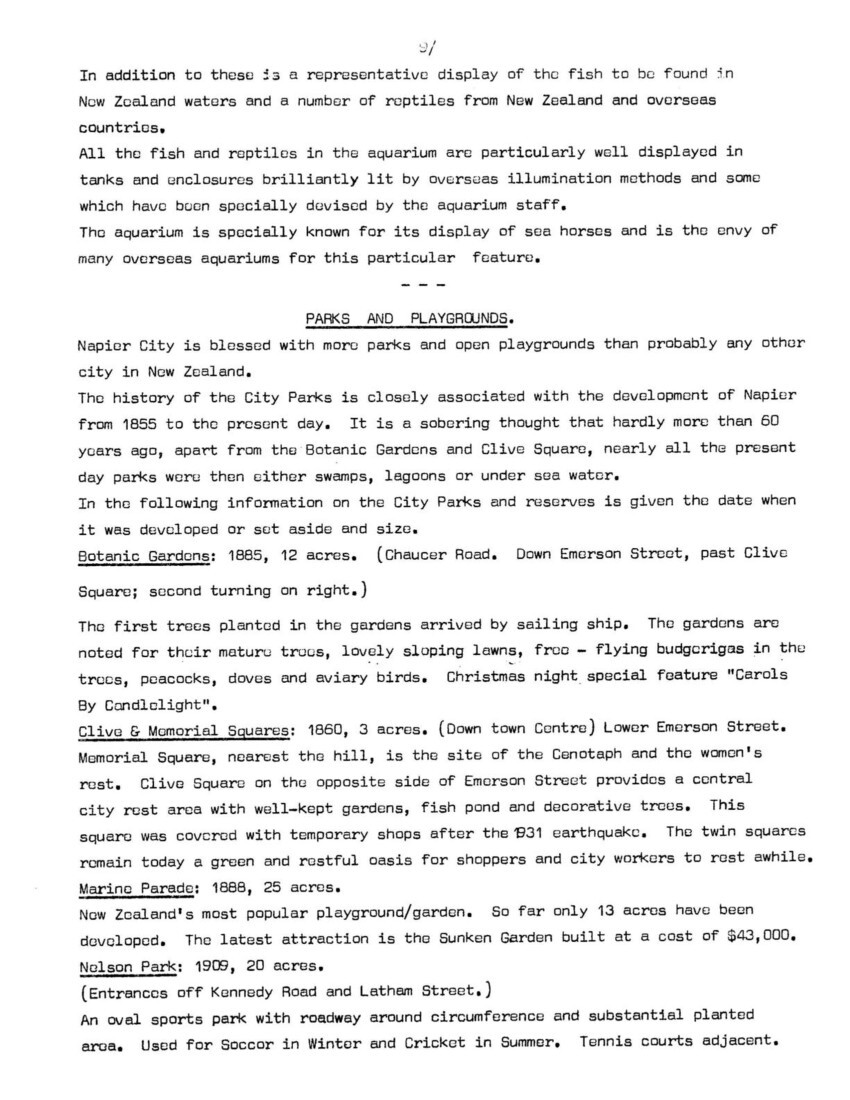
10/
McLean Park: 1911, 10 acres.
(Entrances off Morris Street and Latham Street.)
The home of Hawe’s [Hawke’s] Bay rugby and Athletics. Covered seating on three stands for 4,200 increased as required to 25,000 by temporary seating. Centennial Hall at South – Western end provides stadium for indoor sports. The city’s water supply comes from artesian wells in the park.
Tiffen Park: 1912, 3 acres.
(Entrances off Tennyson St., behind Municipal Theatre and Cameron Road.)
This hillside park provides shady paths leading up the hill with views overlooking the city and bay to Cape Kidnappers.
Georges Drive: 1908, 48 Acres.
(Entrance North from Thackeray St; South from Ellison Street.)
This garden and waterway stretches from the eastern to western boundary of the City residential areas. It consists of the fromer [former] banks of the Tutaekuri river before diversion. It is a free open area and is as important to Napier as the green belt to inner London.
Marewa Park: 1934, 18 acres.
(Entrance from Herrick Street).
The first of the sports parks developed after the earthquake. The home of hockey in Napier. Bowling and croquet greens and Children’s play equipment have been established in the park. The park provides eight hockey fields.
Kennedy Park: 1937, 17 acres.
Developed into City Camping Ground and recognised as one of the best in the country. In 1951 the adjoining rose garden was planted and contains approximately 3,000 roses.
Ahuriri Park: 1939, 10 acres.
(Entrance off Battery Road, western side of hill.)
This park was originally a tidal lagoon and drained with the earthquake. It was first used as a dump. It is a sports ground used mostly on Sundays by social clubs and visiting ship’s crews. Also site for circuses.
Onekawa Park: 1946, 20 acres.
(Entrances from Maadi Road and Flanders Avenue)
The home of fresh-water swimming in the city. The Olympic Pool and aquatic centre were opened at the park in 1964. Also 12 all-weather tennis courts. Used for tennis in Summer and Netball in Winter. The park also has Children’s play equipment.

11/
Whitmore Park: 1957, 20 acres.
(Entrances off Douglas McLean Avenue and Barker Road)
This park is Napier’s secondary Rugby Park in winter. It houses the club rooms of the Tech O.B. [Old Boys] Rugby Club, the Revue Roller Skating Club’s rink, bowling rinks, the Bridge Club and Pottery Club.
Pirimai Park: 1966, 6 acres
(Entrance off Balliol Crescent.)
Another small neighbourhood park with some play equipment to serve the suburban area.
Pirimai South Park: 1969, 4 acres
(Entrance off Trinity Crescent.)
Another small neighbourhood park next to primary school.
Anderson Park: 1962, 88 acres
(Entrance of [off] Taradale Road).
This park was for former racecourse and is currently under development. It is about four miles out towards Taradale Suburb. It is planned to develop this park mainly for passive recreation with play areas, model boat sailing etc.
Maraenui Park: 1969, 15½ acres.
(Entrance off Douglas McLean Ave)
New area yet to be developed as park.
Taradale Park: 13½ acres.
(Entrance off Puketapu Road).
On this park there are tennis and croquet clubs, an athletic track, two cricket tables and two Rugby grounds. Also a children’s play area and small rose garden.
Bledisloe Park, Taradale: 4 acres
(Entrance off Meeanee Road).
This park is used for Soccer in Winter and Softball in Summer.
DOMAINS
Westshore Beach: 23 acres.
Beach beautification began in 1942 and tree and grass planting have progressed. It is basically a beach picnic area with some play equipment.
Westshore Lagoon: 1953, 124 acres.
(Entrance by Westshore Camp).
Being developed with plantings into wild life reserve for waterfowl and wading birds.
Papakura Domain: 92 acres.
(At Meeanee, South-east of Taradale).
Car racing track, rodeo and axemen’s clubs operate on the Domain.

12/
Bluff Hill Domain: 1957, 2½ acres.
(Entrance off Lighthouse Road).
Site of Napier’s look-out – 335 ft.
INTEREST POINTS.
There are many interest points in Napier which are not the obvious ones, but which are well worth considering by the visitor.
The Ahuriri Boat Harbour: This is sited on the north western side of the hill area and was formerly the Inner Harbour which was destroyed by the earthquake in 1931. It is now the headquarters of the Napier Sailing Club and provides safe mooring for the city’s pleasure boat craft and the smaller vessels of the fishing fleet.
The Iron Pot: This rectangular section of former inner harbour also provides marina-style moorings for the pleasure and fishing fleet and was named the Iron Pot because it was at this point that the early whalers boiled the whale blubber for oil. One of the original iron pots used by the whalers is on display nearby.
Onekawa Park Aquatic Centre: This is sited in the Onekawa Suburb of Napier and is a particularly fine concept of an aquatic centre. It has an olympic pool, a heated pool, a diving pool, and paddling pools for children. The centre also has a unique ‘wet’ play area with novel children’s play devices based on ideas gained in Germany. The park itself has many unique play features for children and is considered one of the best in the country.
Look-outs: There are four suggested look-outs on the Napier hill area from where the visitor can obtain panoramic views of various parts of the city and the surrounding areas. The main one is the Bluff Hill look-out on the top of Bluff Hill overlooking the Port of Napier. Of interest also at this point are the two gun emplacements which are relics of the Second World War Coastal Defences. From the Bluff Hill Look-out a panoramic view of the bay can be obtained and a gull’s eye view of the port facilities 300 feet below.
Other look-out points are from Park Road at the back of the Napier Hospital which gives an unrestricted view of the old port of Ahuriri and the huge wool stores, and a look-out point from the end of Simla Terrace which gives a panoramic view of the housing suburbs of Marewa, Onekawa, Pirimai, Maraenui, Tamatea and the former borough of Taradale in the distance. Another popular look-out point is from Clyde Road which gives an intimate view of down town Napier and the Marine Parade.
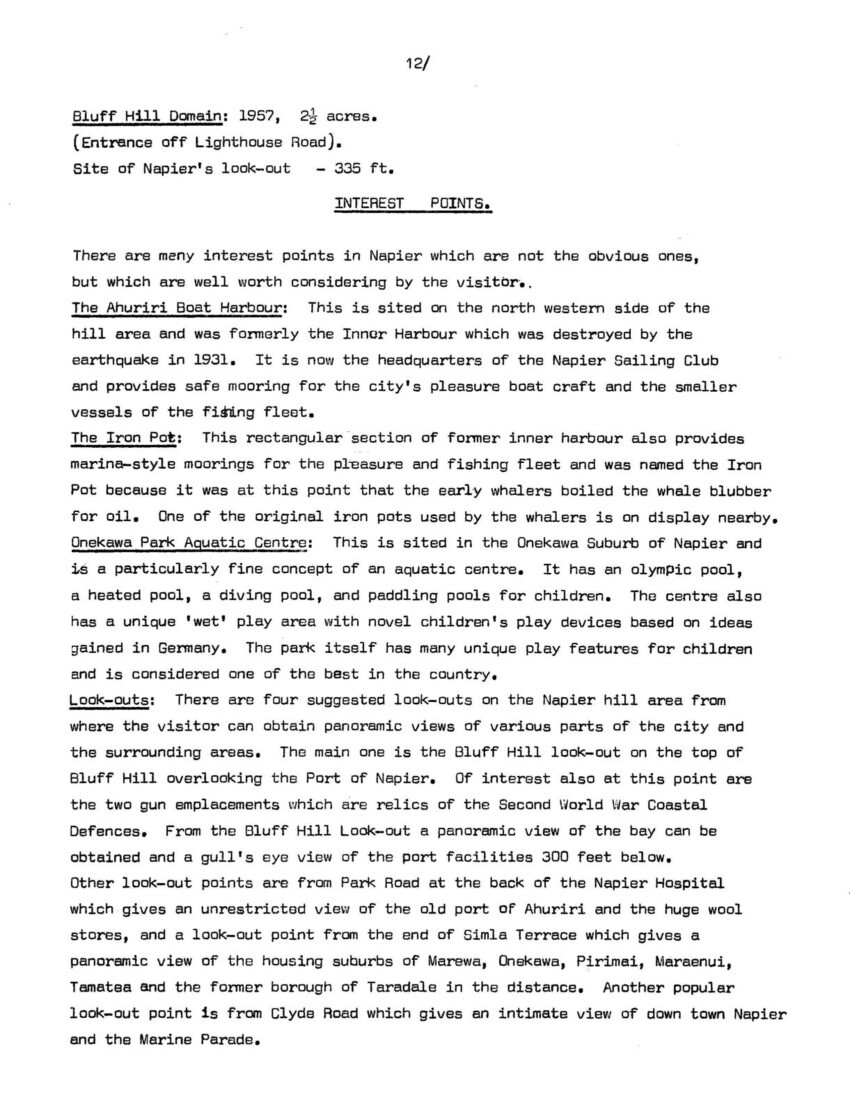
13/
Art Gallery & Museum: This is sited in Herschell St, in the City and contains a wide variety of interesting art works and artifacts [artefacts] of the early Maori and European days of Napier City. It also contains a fine literary and photographic record of the Napier Earthquake of 1931.
Rose Gardens: Napier has fine rose gardens adjoining Kennedy Park, the city’s camping complex in Storkey Street.
Waiapu Cathedral: This great Cathedral with its 125 ft tower dominated the north end or down town Napier. It is always open for inspection by visitors. In the forecourt is an attractive fountain and gardens.
Planetarium: Napier is one of the few cities in New Zealand to have a planetarium. This is situated in the Planetarium building with the entrance from Herschell St, The Zeiss projector gives an amazing portrayal of the heavens and the lectures which accompany planetarium sessions are of absorbing interest.
Symbolic Statue: Set in a unique water feature is a fine bronze symbolic statue on the Marine Parade out towards the City Boundary. This is the latest addition to the Parade features.
FACTS AND FIGURES ON NAPIER
Napier has been developed on four distinct landforms. The hill area, originally an island with an average height of 300 ft above sea level, the shingle spits forming Westshore and the Marine Parade, the new suburbs on land raised by the 1931 earthquake and Taradale on alluvial soils adjacent to the western hills.
Age: Pioneer founders arrived in December 1850
City Population: 40,185 (1971 census)
Altitude: Sea Level to 340 ft.
Latitude: 39 degrees 29 min. South
South Longitude: 176 degrees 56 min. East.
Size: 6020 Acres.
Temperature: Summer Average 72 degrees
Winter Average 52 degrees
Rainfall: 31.2 inches average.
Weather: Sunshine 2281 hours yearly Av.
Snow Nil
Hail 1.4 days yearly Av.
Thunder 4.5 days yearly Av.
Fog 5.00 days yearly Av.
Frost 35.5 days yearly Av.
Wind 60 m.p.h and over; 0.4 days
40 m.p.h. and over; 23.8 days
Calm; 35 per cent of year
4 to 16 m.p.h. balance of year
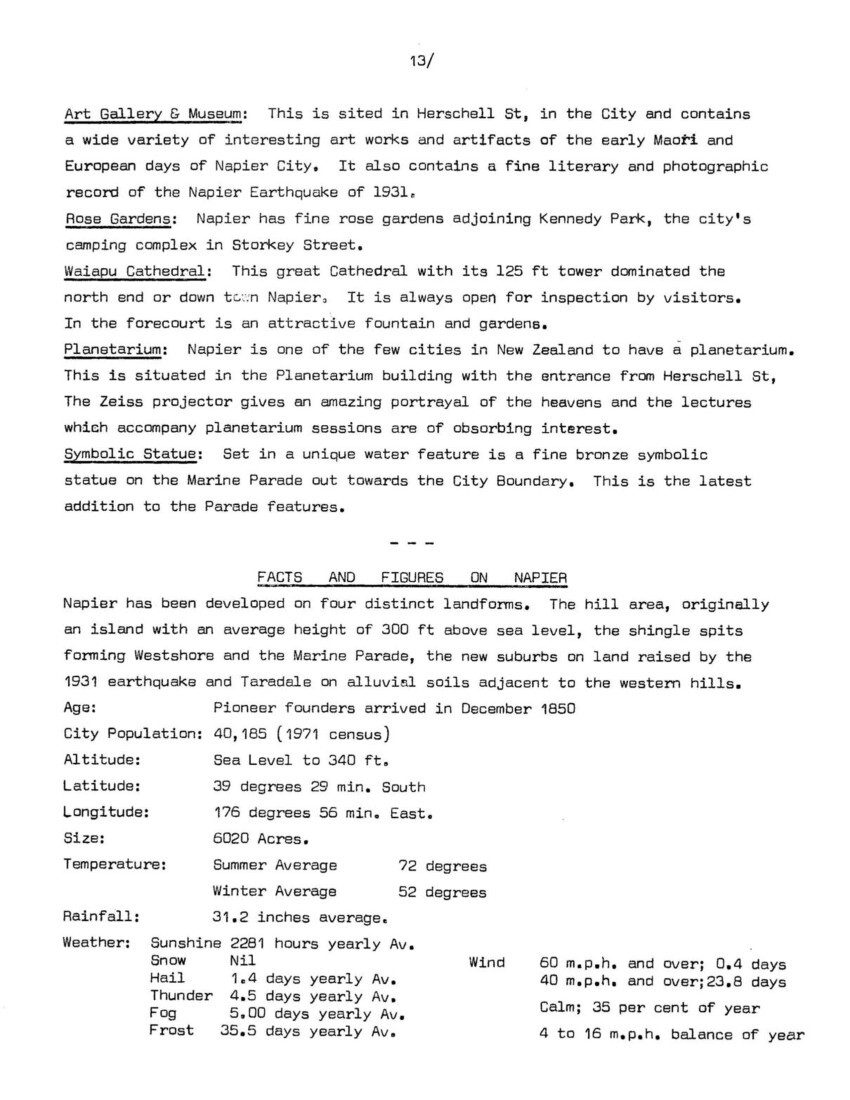
14/
NAPIER HAS ITS OWN PERSONALITY
Napier City has a personality all its own . . . so visitors discover.
Napier as visitors see it today really started after earthquake and fire raised [razed] the city in February 1931. But, of course, its history goes way back beyond that – for 130 years or more. Seasonal whalemen in the 1830’s were the first to live there. It was at the old port of Ahuriri (on the northern side of the hill) that the first houses were built about 130 years ago.
By the mid-1850’s an area south of the hill had been surveyed and set out for the township. British rule had just been established in India and this influenced the naming of the early streets and the town itself after Sir Charles Napier, conquerer [conqueror] of Sind in India.
The town became the seat of provincial government and developed steadily as the outlet for the Hawke’s Bay province. It was, however, hemmed in by water – the sea to the east and north and salt marshes and swamps on the other two sides. Reclamation was slow and town growth seemed to have reached its limits by the late 1920’s.
February 3, 1931, however, saw the town razed by earthquake and engulfed by fire. Grievous as this blow was at the time it ushered in the new Napier as visitors see it today. The convulsion raised the land by about seven feet and thus drained the marshes, swamps and lagoons which up till then had impeded Napier’s expansion. The citizens re-built their city and with a new 10,000 acres of dry land to expand on to, expand they did.
Industries, houses, wool stores – even the airport – now replace the swamps and marshes.
So when visitors venture out from down-town Napier into the picturesque suburbs they can think for a minute that had they been there 40 years ago you would have been travelling out there by boat.
And as they walk along the Marine Parade gardens they can also reflect that underneath them lies the wreckage of the old Napier . . . because that’s where it was buried.
Napier City’s motto on its coat-of-arms reads: “Faith and Courage.” It is an apt and lasting memorial to a people who rolled up their sleeves in 1931 and rebuilt their city.

15/
There is no need to tell visitors that Napier is one of the most blessed of all New Zealand Cities in its natural setting. They will see that for themselves. It looks out on the blue Pacific from the great sweep of Hawke Bay – there’s no land between Napier and Chile – and has the background of the rich green farming hinterland backing up in rolling foothills to the majestic Ruahine and Kaweka mountains.
It’s as nice a site for a city as you could imagine.
Napier’s economy is based on its port and the industries which support it – wool, meat, fruit, dairy produce, frozen products and all the rest of the good things which the province produces for overseas and internal markets.
It has developed its own manufacturing industries and others have come to take advantage of the unequalled climate, good living conditions and top civic amenities and services.
With this background and virile development of commercial and holiday facilities entertainment happens naturally in Napier.
The new city’s youth, climate, scenic setting and the wide range of uncrowded outdoor recreation, have all contributed to its special personality.
SIDE TRIPS FROM NAPIER.
When visitors have ‘seen the sights’ of Napier City there are a number of side-trips which involve half a day or a day with a picnic thrown in for good measure.
Most of these involve county parks and reserves and all are worth a visit. They are all scenic and each has its own particular interest.
Eskdale Park: 10 miles from Napier on State Highway 5 to Taupo. It is a popular riverside reserve and picnic area with toilet facilities and sports playground.
Lake Tutira: 29 Miles from Napier on State Highway 2 to Wairoa. The lake surrounds offer a wealth of delightful picnic areas well laid out with toilet facilities. The lake provides good trout fishing and is a bird sanctuary.
Waipatiki Beach: 29 miles from Napier. Leave State Highway 2 at Tongoio [Tangoio], turn right over hill road then right down to Waipatiki Beach. Bush reserve and golden sand beach. Good swimming and surfing and sea fishing off rocks.
White Pine Bush: 20 miles from Napier on State Highway 2. Native bush reserve with bush walks and picnic area. Toilets.

16/
Rakatanu Forest: 36 miles from Napier. Leave State Highway 2 at northern end of Lake Tutira. Turn left to Waikoau. Man-made forest of exotic and natives.
Dartmoor: 12 miles from Napier. Via Puketapu. Turn right at Taradale Post Office. This river picnic spot is popular.
Hutchinson’s Domain: 40 miles from Napier on Puketitira [Puketitiri] Road. Turn right off road to Taradale. Picnic and sports area.
Ball’s Clearing: 45 miles from Napier at Puketitiri. Natural bush clearing.
A visit to Puketitiri – either to the Hutchinson Domain or Ball’s clearing would not be complete without calling at Mr L. Lemmon’s Colonial Museum on the way.

Non-commercial use

This work is licensed under a Attribution-NonCommercial 3.0 New Zealand (CC BY-NC 3.0 NZ).
Commercial Use
Please contact us for information about using this material commercially.Can you help?
The Hawke's Bay Knowledge Bank relies on donations to make this material available. Please consider making a donation towards preserving our local history.
Visit our donations page for more information.
Format of the original
Typed documentDate published
1971People
- L Lemmon










Do you know something about this record?
Please note we cannot verify the accuracy of any information posted by the community.